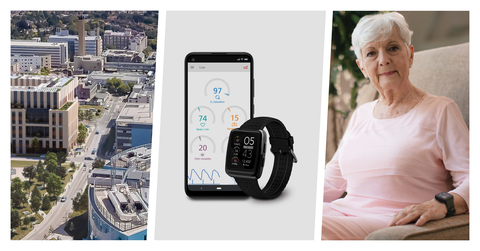
Neuchatel, Switzerland:
Masimo (NASDAQ: MASI) today announced that Cambridge University Hospitals NHS Foundation Trust, U.K. is adopting the Masimo W1™ advanced health tracking watch for use in its telehealth and telemedicine programs. Masimo W1, which offers accurate, continuous measurements of key physiological parameters, is available in the UK as a medical device that integrates with the Masimo SafetyNet® remote patient management platform.

Masimo W1™ (Photo: Business Wire)
Joe Kiani, Founder and CEO of Masimo, said, “Masimo W1 represents not only the future of personal health but is playing a vital role in the expansion of remote healthcare. Built on our decades of expertise developing breakthrough noninvasive medical monitoring technologies, Masimo W1 is designed to aid valued hospital partners like Cambridge in accelerating their virtual hospital and telehealth programs – ultimately helping to improve patient outcomes while reducing the cost of care. We are excited for Cambridge clinicians and patients.”
Cambridge University Hospitals NHS Foundation Trust launched its virtual ward program in 2022, as part of a National Health Service (NHS) England telehealth initiative designed to promote earlier patient discharge to the home. More than 20 specialities across the hospital now participate in Cambridge’s virtual program, which sends patients home with a variety of Masimo products – such as MightySat® and wearable medical devices like Radius PPG®, Radius Tº®, and now Masimo W1 – that allow monitoring and vitals signs data to be relayed to clinicians back at the hospital. Via the Masimo SafetyNet clinician dashboard, hospital clinicians can keep an eye on their patients’ physiological status from afar, allowing patients to stay monitored in the comfort of their own homes.
Dr. Iain Goodhart, Clinical Director of the Virtual Hospital Program at Cambridge University Hospitals NHS Foundation Trust, commented, “Masimo W1 will help us expand our Virtual Hospital program by offering continuous monitoring of oxygen saturation and pulse rate, as well as ECG spot-checking, in a comfortable, easy to use watch. We hope that, integrated with Masimo SafetyNet, the telehealth platform we already use, Masimo W1 can help support more confident patient discharge and management for patients who, before our Virtual Hospital program, might have needed to stay longer in the hospital. We’re excited to incorporate Masimo W1 into our telehealth practices.”
Masimo W1 for use in medical applications is pending FDA clearance in the U.S.
@Masimo | #Masimo
About Masimo
Masimo (NASDAQ: MASI) is a global medical technology company that develops and produces a wide array of industry-leading monitoring technologies, including innovative measurements, sensors, patient monitors, and automation and connectivity solutions. In addition, Masimo Consumer Audio is home to eight legendary audio brands, including Bowers & Wilkins, Denon, Marantz, and Polk Audio. Our mission is to improve life, improve patient outcomes, and reduce the cost of care. Masimo SET® Measure-through Motion and Low Perfusion™ pulse oximetry, introduced in 1995, has been shown in over 100 independent and objective studies to outperform other pulse oximetry technologies.1 Masimo SET® has also been shown to help clinicians reduce severe retinopathy of prematurity in neonates,2 improve CCHD screening in newborns3 and, when used for continuous monitoring with Masimo Patient SafetyNet™ in post-surgical wards, reduce rapid response team activations, ICU transfers, and costs.4-7 Masimo SET® is estimated to be used on more than 200 million patients in leading hospitals and other healthcare settings around the world,8 and is the primary pulse oximetry at 9 of the top 10 hospitals as ranked in the 2022-23 U.S. News and World Report Best Hospitals Honor Roll.9 In 2005, Masimo introduced rainbow® Pulse CO-Oximetry technology, allowing noninvasive and continuous monitoring of blood constituents that previously could only be measured invasively, including total hemoglobin (SpHb®), oxygen content (SpOC™), carboxyhemoglobin (SpCO®), methemoglobin (SpMet®), Pleth Variability Index (PVi®), RPVi™ (rainbow® PVi), and Oxygen Reserve Index (ORi™). In 2013, Masimo introduced the Root® Patient Monitoring and Connectivity Platform, built from the ground up to be as flexible and expandable as possible to facilitate the addition of other Masimo and third-party monitoring technologies; key Masimo additions include Next Generation SedLine® Brain Function Monitoring, O3® Regional Oximetry, and ISA™ Capnography with NomoLine® sampling lines. Masimo’s family of continuous and spot-check monitoring Pulse CO-Oximeters® includes devices designed for use in a variety of clinical and non-clinical scenarios, including tetherless, wearable technology, such as Radius-7®, Radius PPG®, and Radius VSM™, portable devices like Rad-67®, fingertip pulse oximeters like MightySat® Rx, and devices available for use both in the hospital and at home, such as Rad-97®. Masimo hospital and home automation and connectivity solutions are centered around the Masimo Hospital Automation™ platform, and include Iris® Gateway, iSirona™, Patient SafetyNet, Replica®, Halo ION®, UniView®, UniView :60™, and Masimo SafetyNet®. Its growing portfolio of health and wellness solutions includes Radius Tº® and the Masimo W1™ watch. Additional information about Masimo and its products may be found at www.masimo.com. Published clinical studies on Masimo products can be found at www.masimo.com/evidence/featured-studies/feature/.
ORi, RPVi, and Radius VSM have not received FDA 510(k) clearance and are not available for sale in the United States. The use of the trademark Patient SafetyNet is under license from University HealthSystem Consortium.
References
- Published clinical studies on pulse oximetry and the benefits of Masimo SET® can be found on our website at http://www.masimo.com. Comparative studies include independent and objective studies which are comprised of abstracts presented at scientific meetings and peer-reviewed journal articles.
- Castillo A et al. Prevention of Retinopathy of Prematurity in Preterm Infants through Changes in Clinical Practice and SpO2 Technology. Acta Paediatr. 2011 Feb;100(2):188-92.
- de-Wahl Granelli A et al. Impact of pulse oximetry screening on the detection of duct dependent congenital heart disease: a Swedish prospective screening study in 39,821 newborns. BMJ. 2009;Jan 8;338.
- Taenzer A et al. Impact of pulse oximetry surveillance on rescue events and intensive care unit transfers: a before-and-after concurrence study. Anesthesiology. 2010:112(2):282-287.
- Taenzer A et al. Postoperative Monitoring – The Dartmouth Experience. Anesthesia Patient Safety Foundation Newsletter. Spring-Summer 2012.
- McGrath S et al. Surveillance Monitoring Management for General Care Units: Strategy, Design, and Implementation. The Joint Commission Journal on Quality and Patient Safety. 2016 Jul;42(7):293-302.
- McGrath S et al. Inpatient Respiratory Arrest Associated With Sedative and Analgesic Medications: Impact of Continuous Monitoring on Patient Mortality and Severe Morbidity. J Patient Saf. 2020 14 Mar. DOI: 10.1097/PTS.0000000000000696.
- Estimate: Masimo data on file.
- http://health.usnews.com/health-care/best-hospitals/articles/best-hospitals-honor-roll-and-overview.
![]()





















































